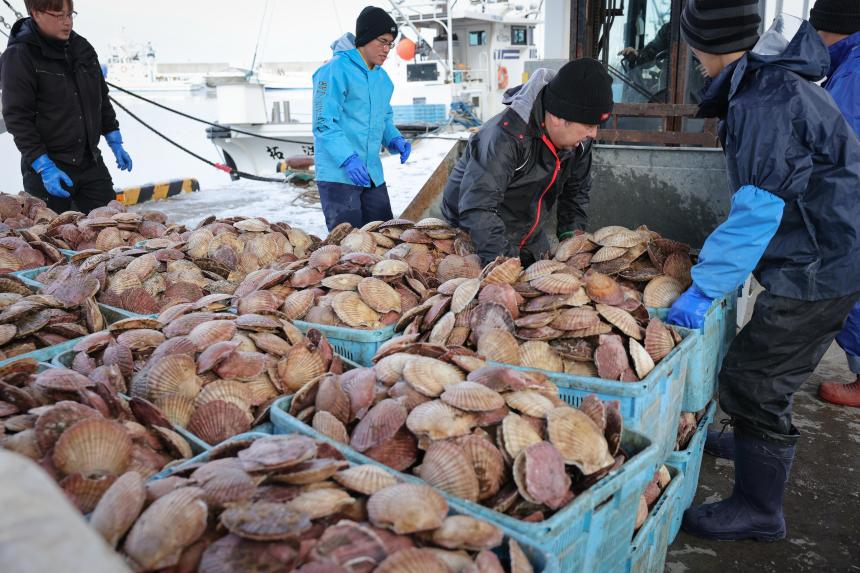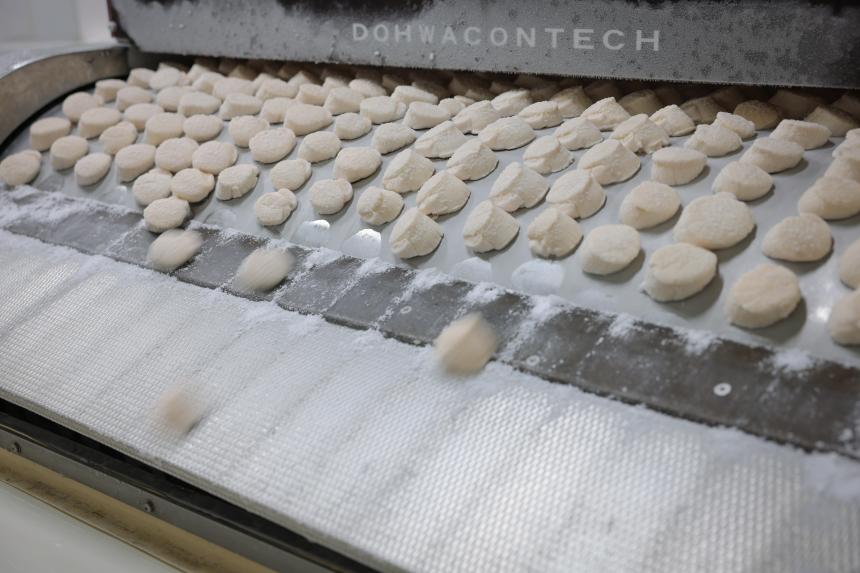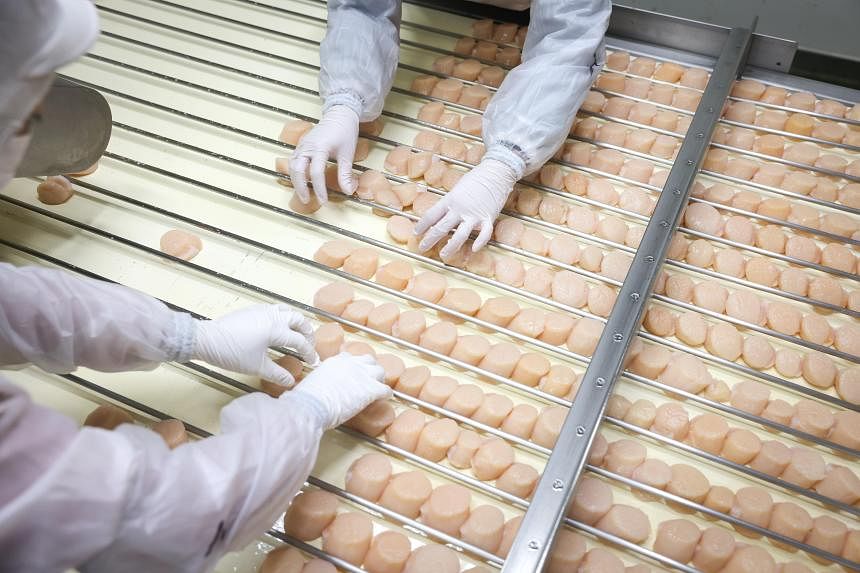HOKKAIDO – In the coming weeks, Singapore will be hearing a lot about scallops from here, seeing them on restaurant menus and, possibly, buying them to cook at home.
Japan is mounting something of a charm offensive, showcasing big, plump and velvety hotate from its northernmost island.
The government-related Japan External Trade Organisation, which promotes trade and investment, has brought groups of journalists, chefs and influencers here to see how the shellfish is farmed and harvested, and representatives from 10 fisheries co-operatives here will go to Singapore in April to talk to seafood traders about bringing in their wares.
The search for new markets is an urgent one, especially after Japan announced it would release treated radioactive water from the wrecked Fukushima nuclear power plant into the Pacific Ocean starting in August 2023.
China, the biggest importer of its seafood, banned all seafood imports, citing safety issues. Russia followed suit. Hong Kong and Macau have also banned Japanese seafood from some regions.
The moves have dealt a blow to the industry, which was recovering from the Covid-19 pandemic and grappling with a decrease in domestic demand from a shrinking population.
News agency AFP reports that some 540 Olympic swimming pools’ worth of water have been collected since an earthquake in 2011 in the Tohoku region triggered a tsunami that caused a meltdown of three reactors at Fukushima-Daiichi nuclear plant.
The plan is to discharge the treated water over 30 years, Nikkei Asia reports. Japan says the discharge is safe, and the United Nations atomic watchdog, the International Atomic Energy Agency, agrees.
Japanese Prime Minister Fumio Kishida has said that China had agreed to talks aimed at addressing the seafood ban.
Choppy waters
Scallops are a big deal for Hokkaido, which the local government calls “Scallop Kingdom”. They are farmed in north-eastern Hokkaido, which faces the Sea of Okhotsk.
In the 1950s, scallops were mostly caught in the wild. This led to overfishing and other problems. Now, scallops are farmed in fisheries in the sea, and the shellfish feed on plankton embedded in drift ice floating down from Siberia, like wild scallops.
According to Hokkaido’s Bureau of Fisheries, the bivalves make up 36 per cent of seafood produced here, with iwashi or sardines coming in second at 20 per cent. Pollack, kombu, salmon and other seafood make up the rest.
Mr Shigeyuki Kobayashi, 59, the bureau’s fisheries food section manager, says more than 80 per cent of scallops produced in Japan come from Hokkaido. The rest come from nearby Aomori, Iwate and Miyagi prefectures.
Some 700 Japanese companies exported US$600 million (S$803 million) worth of seafood products to China in 2022, Reuters news agency reports. It was the largest market for Hokkaido scallops, importing 93 per cent of the scallops produced here in 2022, according to bureau figures.
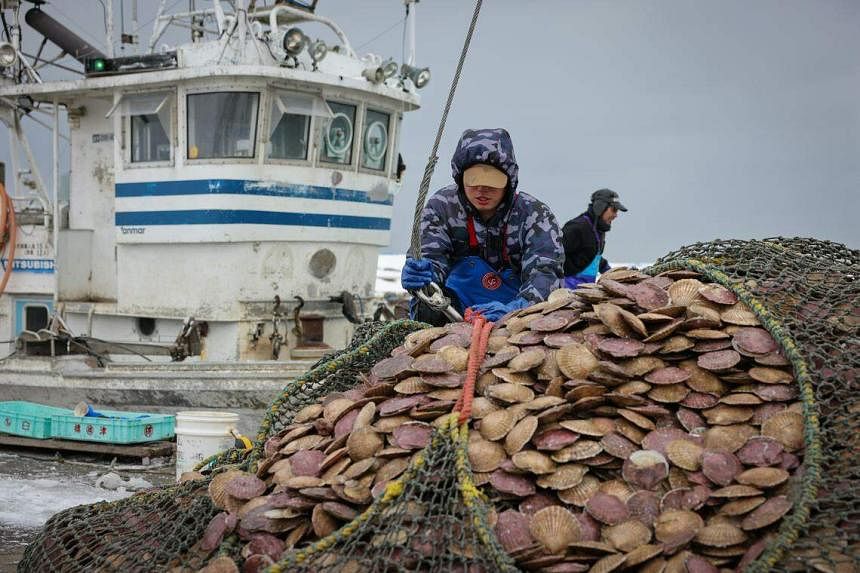
The European Union, the United States, Asean, Hong Kong and other places imported the remaining 7 per cent.
Most of the scallops sent to China were frozen in their shells. Some – an estimated 20 per cent – were consumed there, and the rest processed and sent on to other countries, including the US.
With inventory languishing in freezers, and the price of scallops tanking, Japan has swung into action.
Emergency measures
Shortly after China banned Japanese seafood, Mr Kishida, in August 2023, announced measures to help the fishing industry, to the tune of several tens of billions of yen drawn from government budget reserves.
There are two funds worth 80 billion yen (S$727 million) to help develop new markets and keep excess fish frozen until they can be sold when demand recovers.
Help has also come from the US, which has begun bulk buying Japanese scallops, according to Reuters reports in October 2023, which add that it had not previously bought seafood in Japan.
The scallops will feed soldiers in US military bases and on board vessels. Some will be sold in shops and restaurants on the bases. Reuters adds that the US plans to widen the bulk buying to include all types of seafood.
The Japanese people have also rallied to support the industry. Indeed, those in the business say domestic demand has gone up.
Mr Nobuyuki Moriwaki, 51, executive officer of Sapporo Chuo Suisan, a seafood wholesaler in Hokkaido, tells The Straits Times at Sapporo Central Wholesale Market: “Sales of scallops have not been too badly affected. Demand domestically is strong because the Japanese government has been encouraging us to eat more scallops. That’s been helpful to us.”
Domestic demand has been so strong that the Notsuke Fisheries Co-operative has not resumed exports of scallops to Singapore. These stopped when Covid-19 struck.
Mr Tomoaki Naito, 65, its managing director, says four to five tonnes of its scallop harvest used to be sold by agents to Singapore each year.
In 2023, 70 per cent of the co-operative’s catch was sold domestically, with the rest going to Taiwan and the US.
Why has Singapore been shut out of the harvest of premium hotate?
Mr Naito says: “Prices have been volatile and there is also the weakness of the yen. We are waiting for the price to go up to pre-Covid-19 levels.”
He adds that his benchmark is 6,000 yen a kg for shelled and cleaned extra large, premium scallops, a price not yet met by agents supplying to Singapore.
The bureau’s Mr Kobayashi says the work of looking for new markets and sales channels had started before the China ban, because the declining Japanese population meant a smaller domestic market, and because of fallout from the pandemic and shut borders.
The China ban has just made the task more urgent, he adds.
He says schools in Hokkaido now serve meals with scallops twice a month, and the department has teamed up with Seicomart, a Hokkaido chain of convenience stores, to sell hot, boxed meals featuring scallop curry with rice.
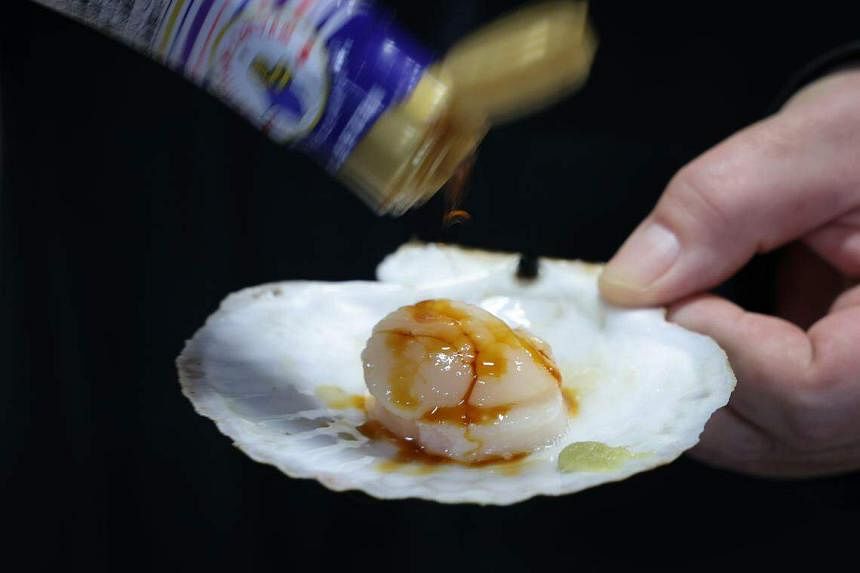
The posters in stores quote Hokkaido governor Naomichi Suzuki’s rallying cry: “Hokkaido seafood products such as scallops have no place to go. Let’s all support one another by eating the safe, secure and delicious Hokkaido marine products produced by fishermen who work hard to produce them.”
The bureau has been working with the Hokkaido Fisheries Federation to encourage the Japanese to eat more seafood by promoting sales in mass retail stores, and by sending out calls to action on social media platforms.
Mr Kobayashi says the federation is also more actively seeking new markets overseas, working with its partners in the US, Australia, Thailand, Vietnam and other countries. He adds that it is eyeing Asean because the economies of countries in the grouping are stable and the people have “buying power”.
Other initiatives include setting up processing plants in Vietnam and Mexico, to replace the ones in China now used to shell, wash, pack and freeze Hokkaido scallops to dispatch to other parts of the world; promoting other Hokkaido seafood, such as yellowtail and flounder, in overseas markets; and, besides exporting raw seafood overseas, also promote and sell processed products such as canned scallops.
Ensuring safety
Students tucking into Hokkaido scallops in school, office workers grabbing a scallop curry lunch from Seicomart, Japanese people making a point to eat more domestically produced seafood to support the industry are well and good.
But how safe is the seafood?
Mr Kobayashi says: “Regular inspections were done before the China ban. For the Japanese, these are basic measures. We know that Hokkaido seafood is very safe.”
How does he intend to get that message across to people outside Japan?
One of the initiatives involves conducting “shellfish poison tests to confirm safety”, the bureau says. There are also plans to monitor the sea to confirm that the seafood is safe for export overseas and complies with regulations in those countries.
Mr Harutomo Takeda, 62, mayor of Saroma town, a scallop farming area in Hokkaido, points out that the scallops feed on plankton in melted drift ice floating down from Russia, and not from the Tohoku region, where the 2011 earthquake and tsunami happened.
To that, Mr Yoshiteru Abe, 72, president director of the Saroma Fisheries Co-operative, adds that the organisation does tests on randomly drawn scallop liver every week for cadmium and other potentially harmful elements.
It was doing this before the ban and, so far, the scallops have been safe to eat, even after the August discharge of treated water.
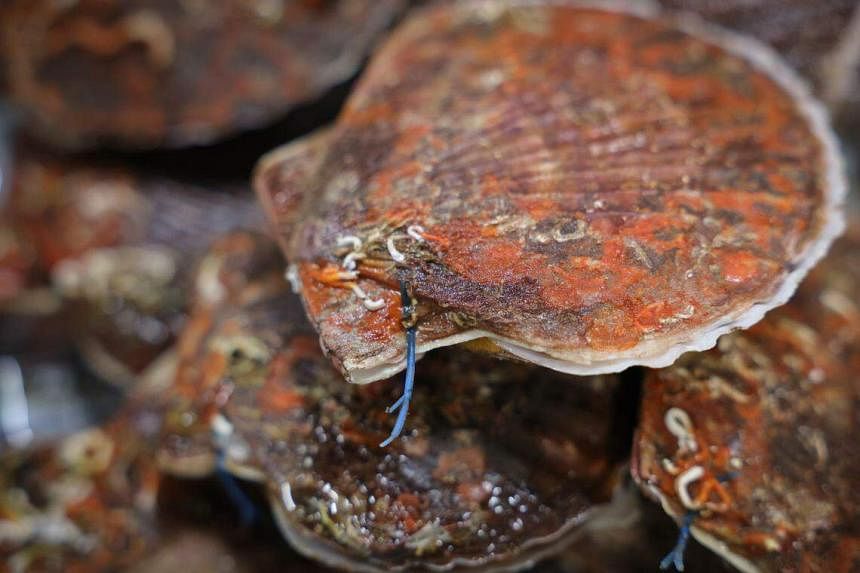
He is invested in ensuring that the scallops are safe because his co-operative is one of three farming “elite scallops” in Lake Saroma. With a surface area of 152 sq km, it is Hokkaido’s largest lake and the third largest in Japan.
He says: “The scallops are bigger and the meat is thicker.”
These premium hotate are what whets the appetite of gourmands overseas, the kind luxe restaurants pay top dollar for. They can fetch upwards of 3,000 yen a kg.
Scallops in the area are usually farmed in the sea. Baby scallops are scattered in the seabed, where they feed on plankton in the water, and grow to 12cm or larger over four years.
Some co-operatives use a farming method where they hang baby scallops on ropes – 60 to 80 on each one – in the lake. There, they are protected from the elements and predators for a year, at least.
At the end of one year, most of the scallops are scattered in the sea to grow for another three years before they are harvested.
Mr Takeda, the Saroma town mayor, estimates that about 700 million of the scallops which spent a year in the lake are then transplanted in the sea. Another 100 million scallops are scattered in other areas – Shibetsu, Mombetsu and Okoppe. The remaining 100 million stay in the lake and these grow, over four years, to become “elite scallops”.
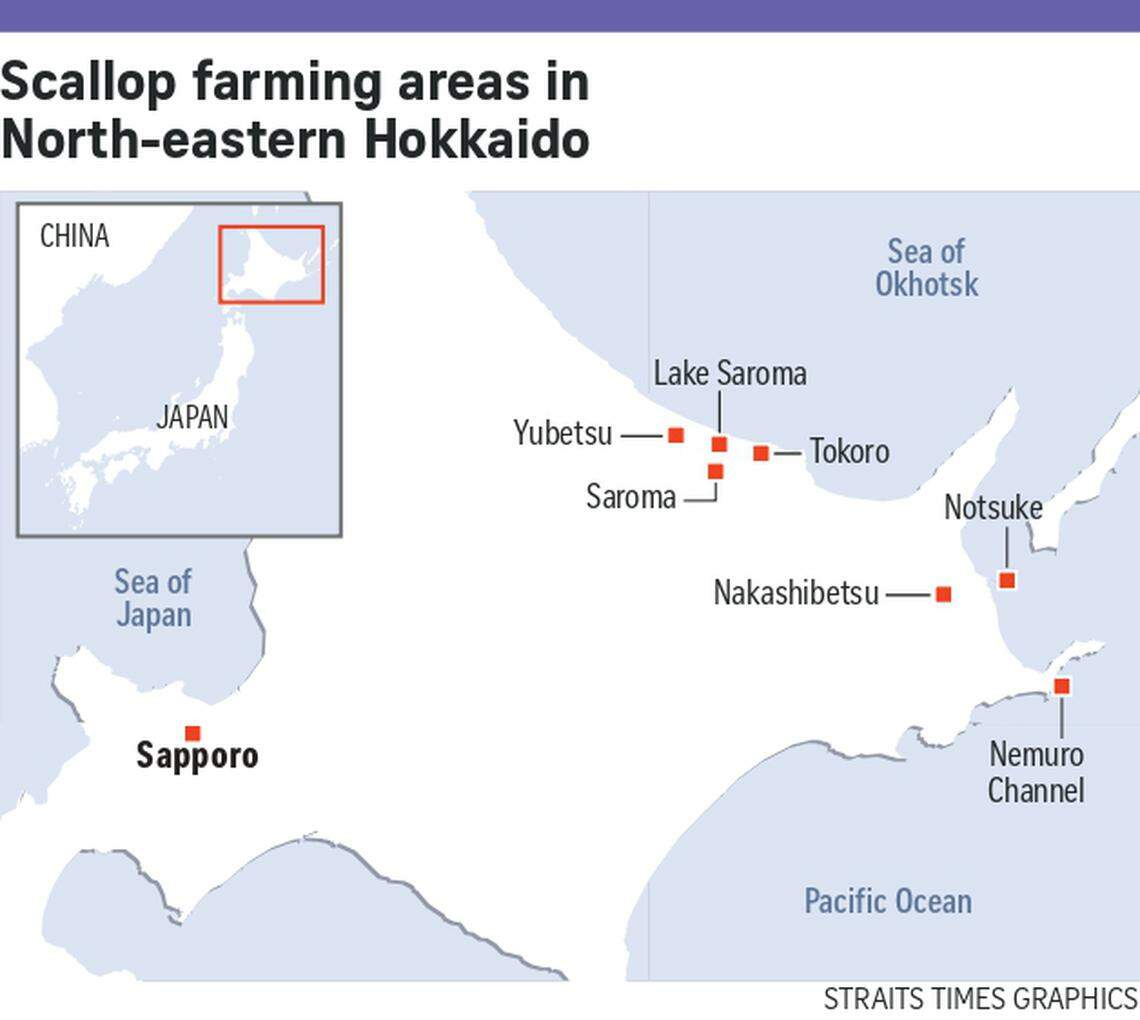
Mr Abe treats visiting journalists to grilled elite scallops, tossed whole onto a grill set over charcoal, where they sit until the shells open.
The scallops are thick and juicy. The coral (the orange roe of the scallop) is similarly plump and rich, and the skirt lightly crunchy. There is no need for salt as the shellfish have just the right level of salinity. Eaten raw, the scallops have a “saku saku” texture – a luxurious springiness – and delicate sweetness.
He will be among the 10 fisheries co-operative bosses visiting Singapore in April to promote scallops.
From sea to Singapore
At least one fisheries co-operative boss is looking at how he can offer people in Singapore that same quality of scallops freshly plucked from the lake or sea.
Scallops, even the premium specimens, are processed before being shipped. In a process that takes four to 12 seconds, depending on their skill, the shuckers open the shells, trim away the skirt, coral, liver and other innards and liberate the prized, ivory-hued scallop meat.
Shells, innards and scallop meat go down different chutes to be processed. The scallop meat is washed numerous times before being sorted and frozen for export or domestic consumption.
Mr Toshio Hirai, 69, managing director of Shibetsu Fisheries Co-operative, is looking to see if there is a better way.
One of his boats takes visiting journalists out from Shibetsu Fishing Port to see how the scallops are harvested from the sea.
He says he might adopt a new technology that involves freezing scallops on the half shell at minus 40 deg C, then packing and sending them overseas.
“I want the scallops to taste the same as when they are fresh,” he says.

Will people in Singapore bite? Many fingers are firmly crossed.
Mr Kobayashi from the bureau says: “Hokkaido seafood has had a connection with Singapore for a long time. We hope that it will continue.”
The writer and photojournalist’s trip was sponsored by the Japan External Trade Organisation and organised by Asahi Broadcasting Group.
